Mount Kailash is a sacred mountain in Tibet. The most sacred mountain in Asia is Mount Kailash. It stands alone deep within Tibet’s Himalayas, the tallest among the surrounding mountains, and is only accessible via perilous roads and hikes. Its majestic attributes are found in its distinctive shape, which has sides pointing in all four directions.
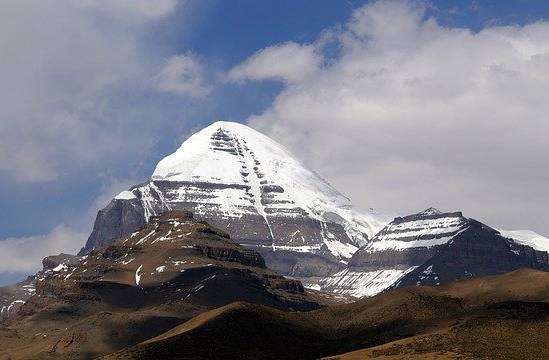
The virgin Mount Kailash (6714 metres) dominates the entire region’s terrain in a distant corner of Tibet’s unique west. Mt. Kailash’s celestial beauty is not only captivating, but it is also the ultimate pilgrimage destination for Hindus, Buddhists, Jains, and Bons from all over the world. Mount Kailash is the spiritual heart of all four religions. Thousands of worshippers visit the holy Mt. Kailash every year to seek spiritual purification.
The outward form of the mountain isn’t the only thing that distinguishes it. For many religions in the area, Kailash is a sacred spot. Mount Kailash is the earthly manifestation of Mount Semeru, which is the spiritual centre of the cosmos, according to Buddhist and Hindu mythology. Mount Kailash wields great power since it is the focal point of the cosmic system
The mountain is the throne of the Hindu god Shiva, according to Hindu mythology. Demchong, the highest tantric meditation god in Buddhism, resides on the mountain and embodies absolute happiness. Mount Kailash was considered sacred by the native Bon religion long before Buddhism arrived in Tibet.

Mount Kailash is where their founder Shenrab descended from heaven, according to Bon legend. As a result, Bon believers think that the entire territory surrounding Kailash is mystical and that the mountain itself is a nine-story swastika that houses all spiritual force. Mount Kailash is the source of the four rivers that can give life to all of these religions: the Indus, Brahmaputra, Karnali and Sutlej.
The earth is divided into four sections by these four rivers. Pilgrims from these three religions follow an old custom dating back thousands of years by trekking through the Himalayas to reach Kailash. They embark on these profoundly spiritual and life-changing trips in order to become closer to God and affirm their commitment to their religion and culture. Pilgrims conduct a 57-kilometre circle around the peak once they arrive (Tibetan Review). Pilgrims walk clockwise in Hindu and Buddhist traditions, but counterclockwise in the Bon tradition.
A pilgrim’s present lifetime’s sins are erased with a single trip around the mountain. In 108 revolutions, all of the sins of countless lifetimes will be erased, and salvation will be achieved. Pilgrims can also achieve salvation in a single circle by immersing themselves in the extremely cold waters of Lake Mansarovar, which is located at the mountain’s base.
It can take anywhere from one day to three weeks to complete a journey around Kailash Mountain. Because they execute body prostrations for the full circle, some pilgrims take up to a month. A pilgrim performs a full-body prostration by bending down, kneeling, prostrating full length, making a mark with his fingers, rising to his knees, praying, and crawling ahead on hand and knees up to the marks created by the fingers.
Whether Hindu or Buddhist, individuals of all traditions recognise the importance of the monument and treat it with respect. Out of reverence for the gods and the sanctified, no one is allowed to climb the mountain. Several monasteries and other sacred landmarks surround the peak, which pilgrims frequently visit. Many pilgrims leave offerings such as hair and teeth all over the mountain.
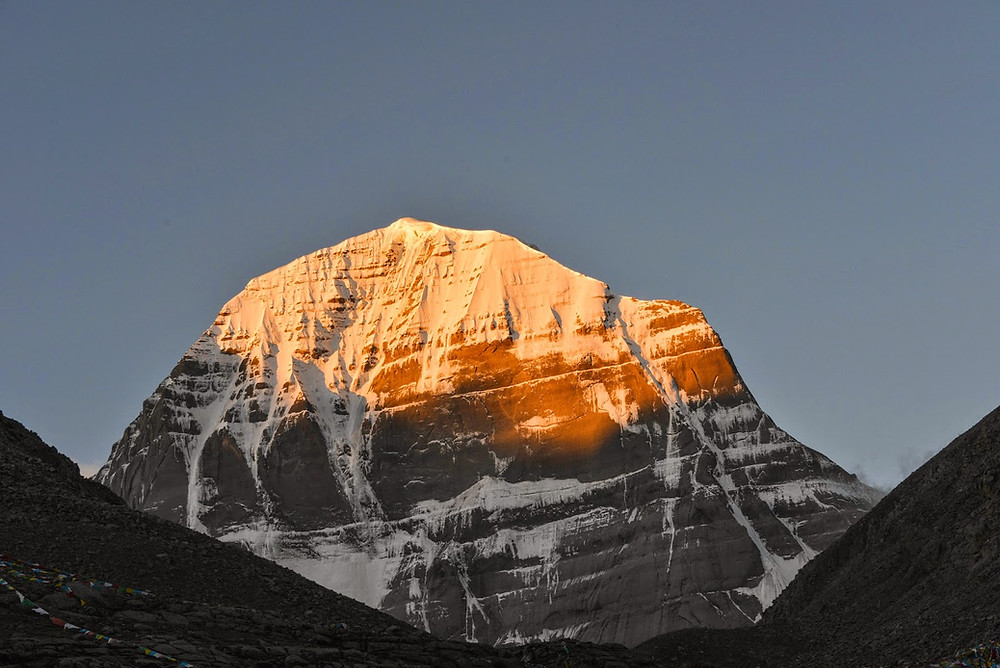
Mount Kailash has religious significance for four religions.
Hinduism
Mount Kailash is recognised in Hinduism as Lord Shiva’s residence, where he lives with his consort Parvati and other gans. He is meditating on the top of the mountain. Kailash has four faces, each consisting of crystal, ruby, gold, and lapis, according to Vishnu Puraan. Pilgrims perform parikrama (or walking around Mount Kailash) in a clockwise direction, beginning at the south face. One circuit of the wheel of life is thought to be similar to one round of parikrama. The mountain is the world’s pillar, and it is from here that the entire cosmos is run.
Kailash is referred to as Shiva’s Abode in Hindu culture. Shiva is not regarded as a God in yogic culture. We think of him as the Adiyogi or the original yogi. He was also known as the Adi Guru or the original guru. He was the first to pass on yogic knowledge to his first seven followers, who became known as the Saptarishis. Shiva is the most powerful mystic we’ve ever met. So when we say “Abode of Shiva,” we don’t mean that you’ll find him if you dig in the rocks or look up in the clouds. It’s because he’d deposited everything he knew in Mount Kailash in the form of energy. He chose this summit to serve as a platform for his knowledge.
The mountain is the throne of the Hindu God Shivwaccording to Hindu mythology. Demchong, the highest tantric meditation god in Buddhism, resides on the mountain and embodies absolute happiness. Mount Kailash was considered sacred by the native Bon religion long before Buddhism arrived in Tibet.
All of Shiva’s knowledge and abilities are very much alive and accessible in Kailash. As a result, many great entities, beginning with Shiva himself, have chosen to deposit and preserve their labour on Kailash. The Bon saints Rishabadev and Agastyamuni, two of the greatest Buddhist instructors, and the Nayanmars Agastyamuni chose Kailash Parvat to preserve their work. Unfortunately, most mystics on the earth consider themselves fortunate if they are able to share even 1% of their work with those around them. The majority of them will never have the opportunity to do so. As a result, they always choose to dump their work in an area that is not frequently visited by humans.
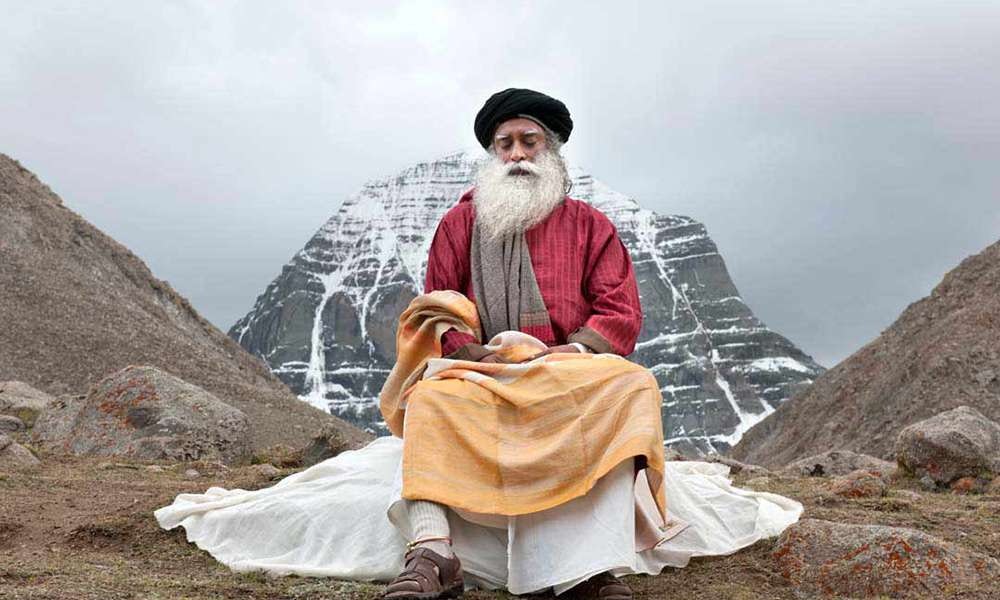
Buddhism
Buddhists refer to Mount Kailash by a different name. Mount Kailash is known among Buddhists as Garu Rimpoche, which means “precious gem of snow” and a massive mandala. It is the home of Chakra Samvara and Guru Rinpoche – Padma Sambhava, who carried Buddhism to Tibet and beyond, according to legend… In Buddhist traditions, Mount Kailash is the most important pilgrimage location. This is where Buddha represents ultimate happiness. Milarepa (Buddhist saint) is considered to be the only person with a pure soul who could ride the sun rays to the peak of Kailash. Pilgrims, like Hindus, perform Kora in a clockwise direction, beginning at Yam Dwar and ending at the south face of Kailash.
Jainism
According to Jain, the first Tiranthkara, Rishabhdeva, obtained moksha (freedom from the cycle of life and death) on the nearby mountain Ashtpad. He came here to learn, and then he wanted to return. However, after being touched by Kailash, he chose to leave everything behind and merge with the mountain.
Bon Tradition
According to Bon tradition, the founder Thonpa Shenrab Miwo came down from heaven to teach his spiritual knowledge on Mount Kailash. It is regarded as a nine-story swastika and a mystical power centre.

Mount Kailash is inaccessible.
The mountain, at only 6,714 metres above sea level, is not one of Tibet’s tallest peaks, yet it has never been ascended by modern man and is unlikely to be because of its special religious importance. Kailash Kora, also known as Kailash Parikrama, is performed by people who believe in Lord Kailash. Kailash Tour cannot be taken on its own. It should be run by a licenced travel and trekking firm. The Indian government operates this travel on a selective basis for Indian pilgrimage. Every year in the month of May, a Nepali tour operator such as Nepal Highland Treks offers a Kailash tour.
Hindus, Buddhists, and Jains regard this mountain as sacred. It is referred to as the centre of the world in ancient texts. The geographical significance of its location explains why: within 30 miles of it are the sources of the mighty rivers Indus (called “Sindhu” in India), Sutlej (in west), Brahmaputra (Yarlung Tsang-po in east), and Karnali (largest tributary to the Ganges in south). According to religious belief, the most sacred and worthy time to make the Mt.Kailash pilgrimage is in the year of the horse, as this holy site is believed to be opened first for pilgrims in the year of the horse, and 2014 is horse year, which occurs once every twelve years, so hundreds of pilgrims would gather.
The Stairway to Heaven
Mount Kailash—the Stairpath to Heaven—is the most fascinating mountain range in the Himalayas, so we thought we’d share some interesting facts about it. It is in fact, is 22,000 feet above the Tibetan Plateau, which is usually regarded unreachable. Mount Kailash is the physical incarnation of Mount Meru for Hindus and Buddhists. Here are ten fascinating, little-known facts about Mount Kailash, one of the world’s most sacred and mysterious mountain peaks.
• The pyramid-shaped Mount Meru, contrary to popular belief, is the result of some superhuman divine beings’ technical competence.
• There are old monasteries and caverns around Mount Meru, according to Buddhist and Hindu texts, where holy sages abide in their material and subtle bodies. Only a few lucky people get to see these caves.
• Thousands of pilgrims visit Tibet each year to visit the holy Mount Kailash. Only a few people make it to the area, and even fewer complete the circumambulation of the sacred summit. Some daring mountaineers have attempted to climb to the summit, but they have failed.
• Hindus believe that trekking all the way to the summit of Mount Kailash is banned because it would trespass on the mountain’s holiness and disturb the holy energies residing there.
According to Tibetan legend, a monk named Milarepa once climbed to the summit of Mount Meru. When he returned, he urged everyone to stay away from the God who was reclining high on the top.
• At the foot of Mount Kailash, two lovely lakes, Mansarovar and Rakshas Tal may be found. Mansarovar, at an elevation of 14,950 feet, is considered the world’s highest freshwater body.
• While Mansarovar has a deep spiritual meaning, its polar opposite, Rakshas Tal, was born of the demon King Ravana’s great austerities in order to serve Lord Shiva. The Rakshas Tal Lake is gifted with salty water due to its strong affiliation with a demonic entity. This Lake is a saline body of water devoid of aquatic plants and marine life.
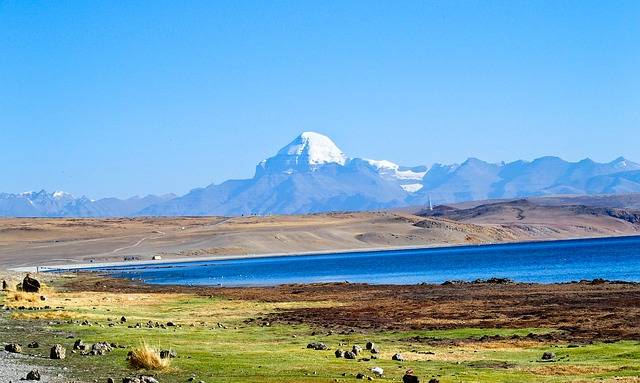
• The Axis Mundi, also known as the cosmic axis, global axis, world pillar, world centre, and world tree, is thought to be Mount Kailash. It’s the place where heaven and earth collide. The accuracy of this data is confirmed by Google Maps.
• Regardless of whether it’s windy or not, the holy Lake Mansarovar’s water remains calm. Rakshas Tal, its next-door neighbour, is also more or less tumultuous. After returning from your Mount Meru excursion, don’t be surprised if your nails or hair have grown a few millimetres.
Tourists and pilgrims have learned that breathing the air from this old summit accelerates the ageing process!
From the Past
• Once upon a time, a party of Siberian climbers got ahead of a specific point and instantly aged by a few decades. Surprisingly, all of the trespassers died of natural causes within a year!
Tibet was invaded by communist China in the early 1950s, and the suppression of religious freedom began. The Chinese authorities implemented the “17 Point Agreement for the Peaceful Liberation of Tibet” in May of 1951. The 14th Dalai Lama signed the accord with much sadness, affirming Chinese rule over Tibet (Dhussa). Some Tibetan government officials claim the delegates were forced to sign the accord, while others claim it never happened.
The Chinese presence in Tibet grew stronger, resulting in severe repression of the Tibetan people. Many religious buildings were destroyed, including six monasteries on Mount Kailash, and monks were imprisoned by Chinese troops in an attempt to suppress religious views. Tibet’s religious freedom was guaranteed by China, but they were not allowed to openly practise their religion. Across the country, uprisings erupted as an outcome. The greatest uprising, in 1959, resulted in the deaths of 87,000 Tibetans and the exile of the Dalai Lama. Access to Mount Kailash was closed at this time, and pilgrims were not permitted to undertake their sacred pilgrimage.
Chineese Presence
The Chinese government began to relinquish its grip on Tibet shortly after the Cultural Revolution. Tibetans have regained some religious freedom by the 1980s. Monasteries were reconstructed, religious relics were repatriated, and Mount Kailash was reopened to the public. For Buddhist, Hindu, and Bon pilgrims wishing to climb the mountain, however, the battle for the sacred ground only intensified. Pilgrims must currently obtain a permit before they may begin their journey.
The permit is provided by the Chinese government and requires a lengthy process; due to inefficiencies and biases in the system, some people are unable to get permits at all. Indian citizens who visit Kailash on occasion experience even more problems as a result of China’s rule. Each year, thousands of Indian pilgrims apply, but only a thousand licences are granted (Timmons).

The requirement for permission isn’t the only source of contention over Mount Kailash. China is currently attempting to turn this hallowed location into one of Tibet’s most famous tourist sites. The Chinese government does not recognise religion and is more concerned with the economic benefits of Mount Kailash. What was formerly nearly impenetrable is now becoming more accessible to western and Chinese travellers. In the area, phone lines and bridges have also been erected. China took its ideas even further in 2006, launching a campaign to build a railroad connecting Beijing and Lhasa (the town near Mount Kailash).
As the number of tourists visiting the region grows, fewer pilgrims are able to fully appreciate the calm journey to the hallowed spot. Tourists and cars now interrupt their prayers, and they are no longer able to appreciate the region’s solitude.
China has made it a point to reduce religious activity in Tibet, which is small and powerless. The Dalai Lama has referred to the war in Tibet as “cultural genocide” because China is imposing its values on Tibet, and a country can only withstand so much pressure (Poriter). However, in recent years, the Tibetan Nation’s determination to preserve its cultural identity has led to a path of recovery. Tibet’s people have sparked international interest in their cause through uprisings and rebellions.
Current Issues
Organizations from all around the world are banding together to help Tibet regain its religious practices. The most effective strategy for Mount Kailash to maintain its sacred status would be to become a UNESCO world heritage site. However, it must be nominated by the Chinese government in order to attain this status (Poriter). Tibet and China are making modest but steady progress toward peace, with the expectation that this peace will provide religious freedom to all Tibetans.
The Dalai Lama representatives met with Chinese leaders for the first time in 2002, nine years after their last meeting, and there have been several more meetings since then. The Dalai Lama advocates for Tibet’s independence. The best method to defend Mount Kailash, however, is for Tibet to achieve complete independence from China.
This conflict exemplifies a number of the concepts we’ve covered in class. One of these issues is the disparity between indigenous cultures and outsiders’ perspectives on physical land. Many indigenous religions regard the mountain as a spiritual centre and so want it to remain in its original state. Meanwhile, the land is viewed as a possible source of profit by outside civilization. The Chinese government is able to enhance tourism and hence its money by ruining the area around Mount Kailash and creating roads, entirely neglecting the cultural and spiritual significance that remains beneath the surface.
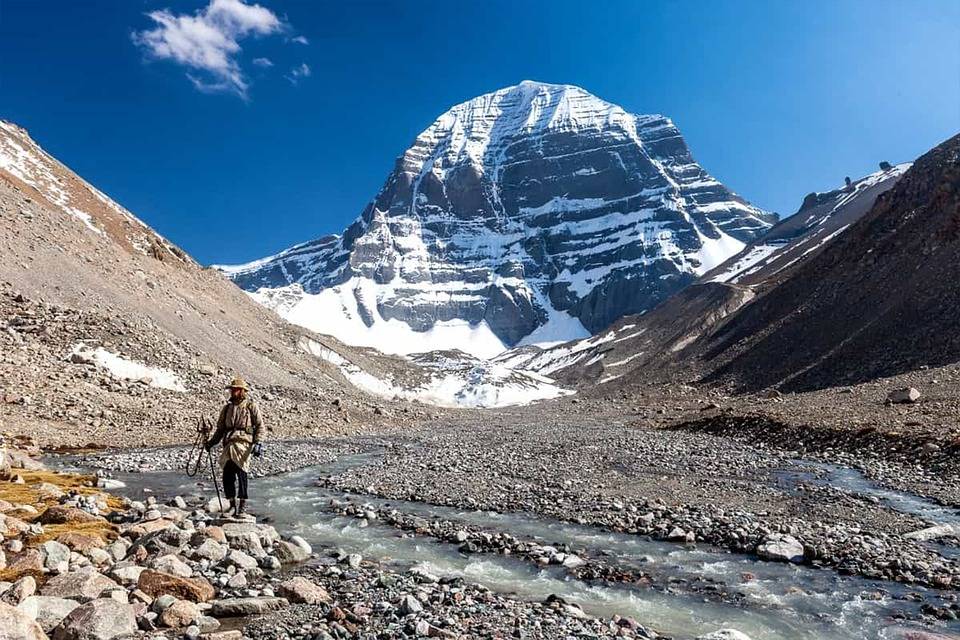
Disclaimer: The author’s views are his or her own. The facts and opinions in the article have been taken from various articles and political commentaries available in the online media and Eastside Writers does do not take any responsibility or obligation for them.
Note: Contact our Writers at www.eastsidewriters.com for writing Blogs/Articles on any niche. We have experts in various domains from Technology to Finance and from Spirituality to Lifestyle and Entertainment.







Pingback: Kedarnath-The Significance And The Key Reasons For Its Visit - Eastside Writers
Pingback: Know About Shiva - And Why Worshipped By Hindus Since Ages - Eastside Writers
Pingback: Is Shiva Devine, Myth, Man, Universal Power, Nothingness, Or Karmic - Eastside Writers